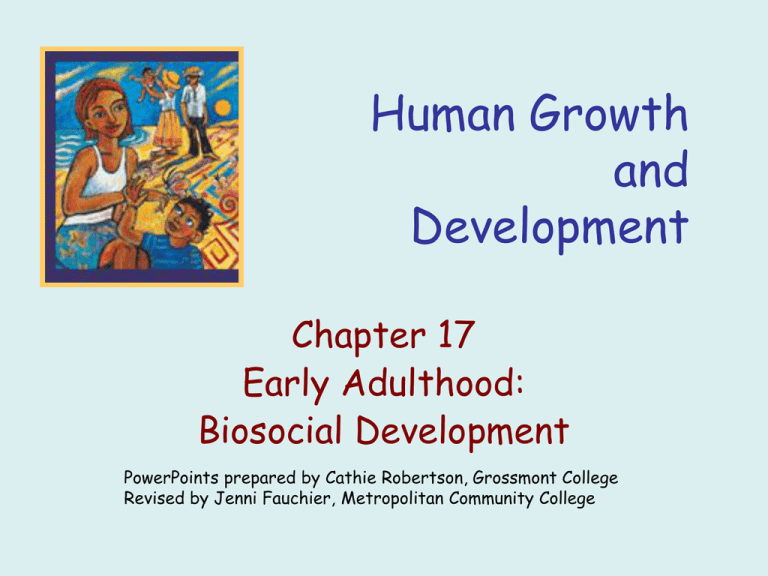
Human Growth
and
Development
Chapter 17
Early Adulthood:
Biosocial Development
PowerPoints prepared by Cathie Robertson, Grossmont College
Revised by Jenni Fauchier, Metropolitan Community College
Growth, Strength, and
Health
• Young adults are strong, healthy, and
disease free
Norms and Peaks
• Men typically stronger than women
• For both sexes, physical strength
increases until 30, then declines
• All body systems functioning at
optimum levels
• Death from disease is rare
– violent death more likely
Signs of Senescence
• Occurs when growth stops but ongoing
throughout adulthood
• Physical decline related to age
– varies markedly from person to person, organ to
organ
• Organs: First visible changes are in
skin--looses elasticity
• Graying hair and male pattern baldness
begin around age 30
• Variability in senescence appears
Gender Differences in
Health and Senescence
• Appearance seems more important
for women than for men
– in some ways, women slower to
become old
– women generally healthier and have
better health habits
• few fatal diseases, live at least 5
years longer than men, on average
Gender Differences in Health and
Senescence, cont.
• Two ways females are at a health
disadvantage
– undernourishment
– reproductive systems problems
Gender Differences in Health and
Senescence, cont.
• Three explanations why twice as many
women than men live to after age 80
– biological: protective evolutionary
biology
– cognitive: less risk taking
– psychosocial: marriage, family life,
friendship, and help-seeking are all
protective of health, and women are
more likely to engage in these
Homeostasis
• Body’s attempt to keep systems in
balance —homeostasis
– set point is affected by genes, diet,
age, hormones, and exercise
• Aging makes it more difficult to
recover from physical stress
• What a 20-year-old can do is more
difficult for a 35-year-old
Reserve Capacity
• Bodies that are maintained
adequately can have greater capacity
to respond to stressful events or
conditions
– if not, our organ reserve capacity
declines
– organ reserve—extra capacity for
responding to unusually stressful events
or conditions that demand intense or
prolonged effort
Reserve Capacity
• Serious reductions are not normally
reached until late adulthood
Sports Stars and the
Rest of Us
• Athletic performance peaks between
ages 15 and 35
• Within a sport, skills peak at
different ages
– super stars more likely to peak
later
• Impact of aging on skills depends on
lifestyle
Sexual Responsiveness
• Typical male sexual response
– sexual arousal and excitement
– orgasm
– refractory period (time between
responses) is short
– overall slowing down over time
Sexual Responsiveness, cont.
• Typical female sexual response
– sexual arousal and excitement and
orgasm take longer than for men
– from early adolescence to middle
adulthood, arousal and orgasm become
more likely
Sexual Responsiveness, cont.
• Explanations of male and female
differences in sexual responsiveness
– both partners learn to match timing in
love making to prolong man’s excitement
and intensify woman’s sexual responses
– cultural
• men expected to be rapid in sexual
response, and women to repress desire
and emphasize control
Sexual Responsiveness, cont.
• Explanations of differences in sexual
responsiveness, cont.
– evolutionary psychology
• promiscuous males produce more
offspring and pass on their genes
more often, which is an
evolutionary goal
• women reproduce and create safe
haven for children
Fertility
• Peak time of fertility for women:
before age 30; for men: before age
40
• Between 2 percent and 30 percent of
all couples experience infertility—
average of 15 percent
– infertility—failure to conceive
after a year of intercourse without
contraception
Fertility, cont.
• Male Infertility
– 1/4 of cases related to sperm/sperm
count
• Female Infertility
– pelvic inflammatory disease may block
fallopian tubes
– endometriosis
– infections, fibroid tumors
• uterine health affected by other health
factors
Fertility, cont.
• Medical Advances
– in vitro fertilization (IVF)—ova
surgically removed, fertilized by
sperm in lab, and allowed to divide
until zygote reaches 8- or 16-cell
stage
– assisted reproductive technology
(ART)— collective name of
different technologies that aid in
fertility
Emotional Problems in
Early Adulthood
• Dieting
• Drugs
• Violence
Dieting as a Disease
• Set point—particular body weight
that an individual’s homeostatic
process strives to maintain
• Dieting is common among girls, not
unusual for boys
• One in 20 teenagers takes dieting too
seriously and has an eating disorder
Dieting as a Disease, cont.
• Culture and diet industry messages
(via media) tell us to be thin so we will
be happy and successful
– almost 50 percent of women in
North America have a BMI of less
than 25, so they are not overweight
at all
– many young women connect selfconcept with body image
Anorexia Nervosa
• Restriction of eating to the point of
emaciation and possible starvation
• Four Symptoms
– refusal to maintain body weight of at
least 85 percent of normal weight for
age and height
– intense fear of gaining weight
– disturbed body perception and denial of
problem
– in females, absence of menstruation
Bulimia Nervosa
• Repeated episodic binge eating
followed by purging
• To be clinically diagnosed,
– bingeing and purging must occur at least
once a week for three months
– the person must have uncontrollable
urges to overeat
– the person must show distorted selfjudgment about body image
Theories: Eating Disorders
• Psychoanalytic: Women have conflict
with mothers, cannot separate
• Behaviorism: For people with low selfesteem, bingeing and purging relieve
states of distress and tension
• Cognitive: Women competing in
business against men want to project
masculine image
Theories: Eating Disorders, cont.
• Sociocultural: Women feel cultural
pressure to be slender
• Epigenetic: Girls who are
overwhelmed by development find
that anorexia stops growth and
decreases presence of sexual
hormones
Drug Abuse and Addiction
• Drug addiction—physiological or
psychological drive to ingest more of
a drug
– addiction begins with use
• Young adults more likely to be addicts
Drug Abuse and Addiction, cont.
• Marked gender, ethnic, and national
variations in rates of drug addiction
– men more likely than women
– European Americans and Hispanic
Americans more likely to use than are
Asian-Americans or African Americans
– English-speaking countries more likely to
use drugs
Drug Abuse and Addiction, cont.
• College students particularly
vulnerable
– more to alcohol
• Social context encourages use and
abuse
–
–
–
–
on their own
rock concerts
spectator sports
other group activities
Drug Abuse and Addiction, cont.
• Consequences of drug use often serious
–
–
–
–
avoid, drop out of, or flunk out of college
work below potential
lose or quit jobs
involved in transitory, uncommitted sexual
relations
– die violently
– experience serious psychological difficulties
Psychopathology
• Many young adults struggle with
serious emotional difficulties
– 12 percent experience at least
one episode of
• depression, schizophrenia, or
pathological rage
• made worse if using drugs or
alcohol
Psychopathology, cont.
• Some difficulties may originate in
childhood
– parents abusive, neglectful, or erratic
– death of mother or alcoholism of
father
• Typically, childhood disturbances,
biological problems, and environmental
stress are all involved
Depression
• Between ages 20 and 35, at least 15 percent
of women and 8 percent of men suffer from
at least one severe episode of depression
• Major depression is fueled biochemically
– neurotransmitters
– hormones
• Remission is likely with treatment that
includes cognitive therapy and medication
Schizophrenia
• 1 percent of all adults experience at
least one episode of schizophrenia
• Caused by genes and severe early
trauma such as anoxia at birth
• Medication seems to be most
effective if person understands
disease
Violence
• In U.S., 1 male in every 100 between the
ages of 15 and 25 dies violently
– motor vehicle accident, homicide, or suicide
• Worldwide, young men more likely to die
violently than women (especially between
ages of 20 and 25)
– 4 times as many commit suicide
– 6 times as many are murdered
– by nation or ethnic group, male-to-female ratio
varies from 3:1 to 10:1
Violence, cont.
• Developmentalists suggest two reasons
– biological—unlike females, in males,
higher levels of testosterone
correlate with impulsive, angry
reactions
– psychological—high self-esteem and
dashed expectations more likely to
result in violence in the presence of
alcohol, a weapon, or lack of selfrestraint




